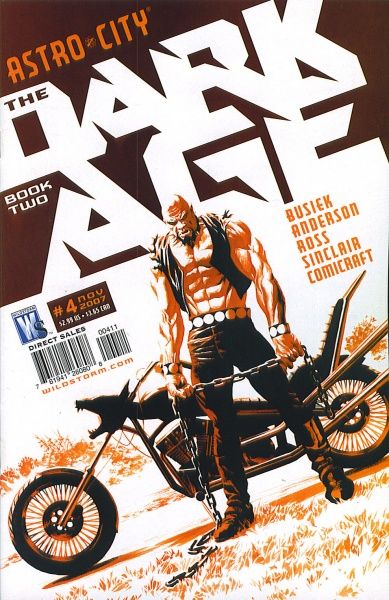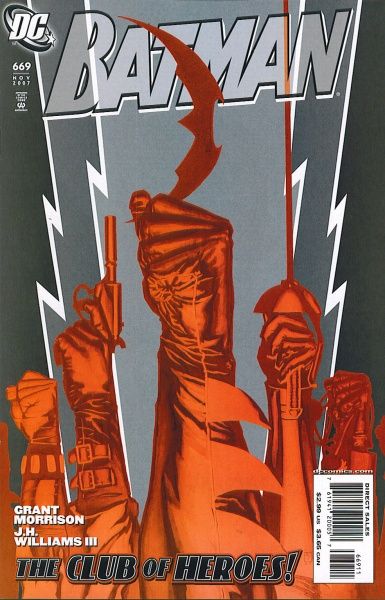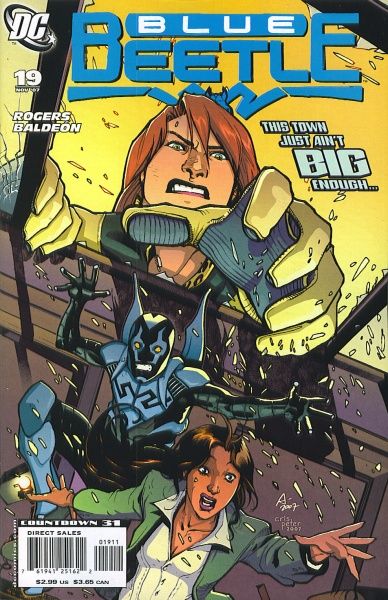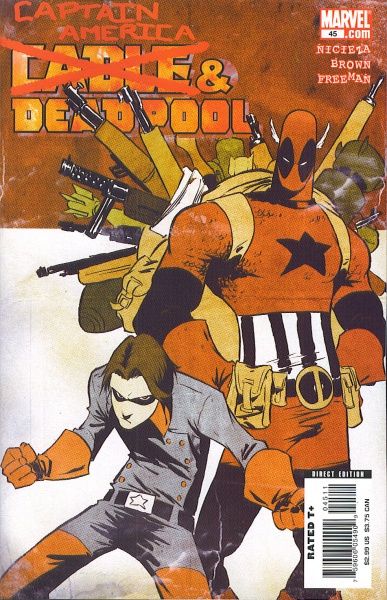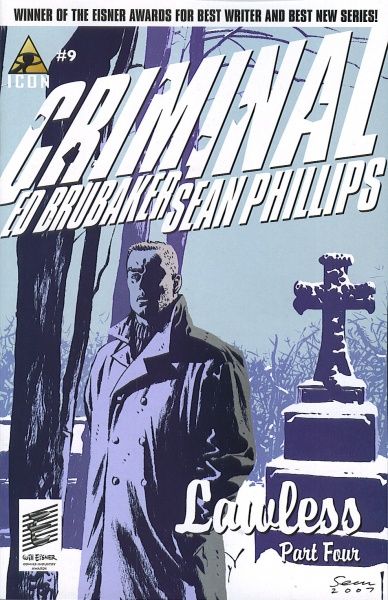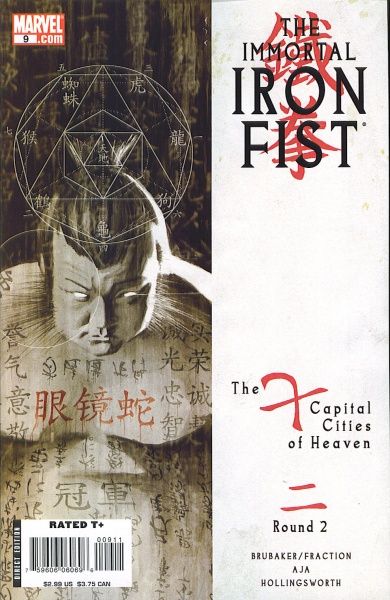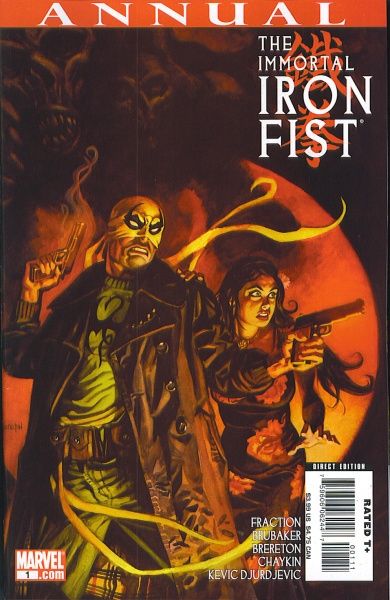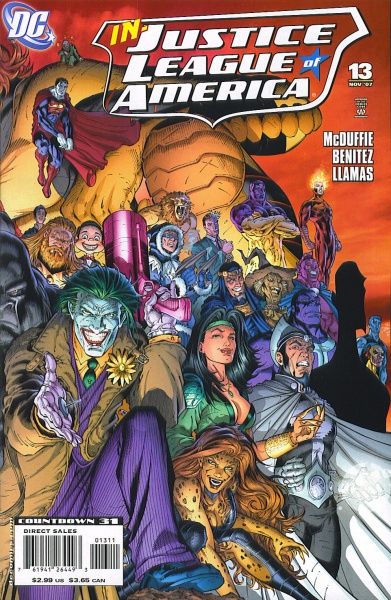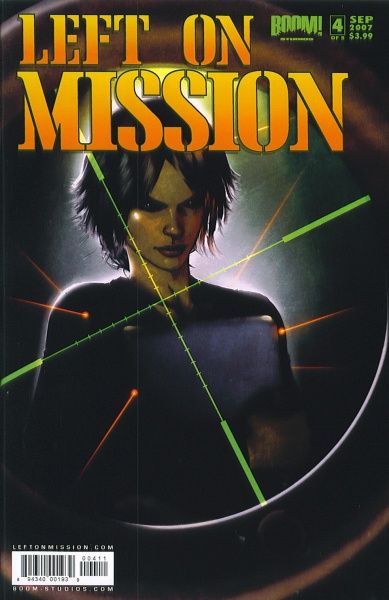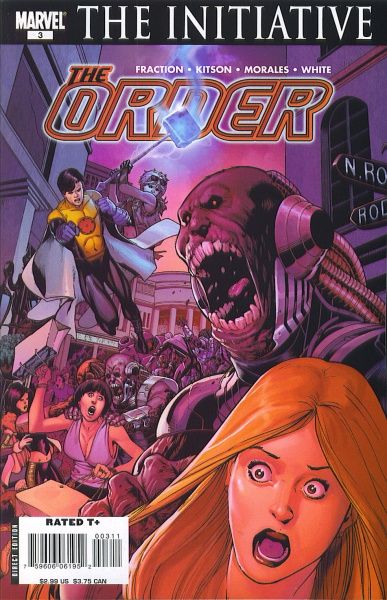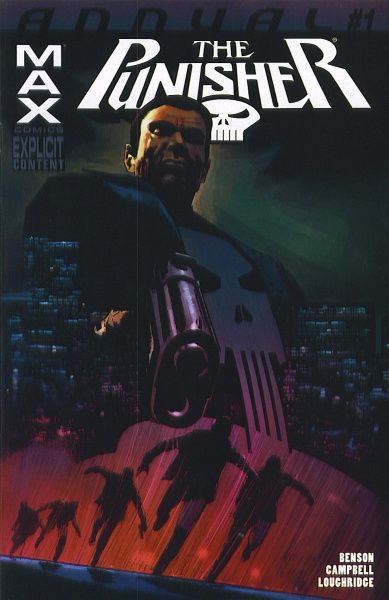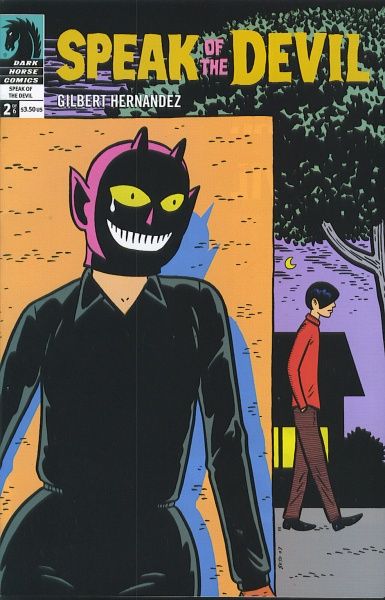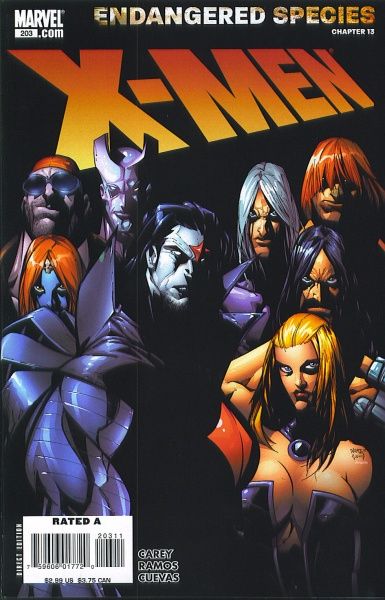There are at least three outright rants this week, and maybe two semi-rants (depending on what your definition of a "rant" is). Now that's quality ranting! Oh, and some reviews. You know, what I'm supposed to do in these posts!
Astro City: The Dark Age Book Two #4 (of 4) by Kurt Busiek and Brent E. Anderson. $2.99, DC/Wildstorm.
There's not a whole heck of a lot I can say about Astro City, is there? I mean, this is the final issue of a four-issue mini-series, which concludes the second of a trilogy of mini-series about a specific time in Astro City history, all fitting into the larger story Busiek is telling. It's not a perfect jumping-on point, in other words. If you like Astro City, it's doing its thing, and if you don't, you probably decided that a long time ago. I will say that Busiek's vision is kind of breathtaking, and I'm more than willing to wait for however long he takes to finish his saga of the city. I'm not even sure if I have any desire to read these comics individually. I read the four issues of this series all at once, and it certainly worked, but there's even more going on that ties into the series as a whole. Busiek does a good job of keeping the series self-contained, but the way he drops some things in there and then moves on - the Incarnate being one of them, the Innocent Gun being another - keeps me thinking that it would be better to read the series after he's finished, because he might take a decade to return to some of the things he brings up. I mean, based on how slowly he pumps these out, we might not learn the Incarnate's story until 2020 or something! So should I just buy the issues, store them away, and wait until Busiek is done? That seems to be the best policy.
Batman #669 by Grant Morrison and his awesome white jeans and J. H. Williams III. $2.99, DC.
It's been a while since I've been this impressed with a Batman story arc, and I certainly hope The God of All Comics has gotten settled into his groove on the title after an uneven start. I'm sure Williams has something to do with how good this story is, but Morrison does a good job making Batman more human than he often is. He does some detecting, he gets angry and self-righteous, but he cares about Tim, as well as the other members of the Club of Heroes. His Batman is far more interesting than the freakishly omnipotent super-dick appearing in many other DC comics. It's as if only Morrison, Dini, and Pfeifer got the memo that Batman wasn't supposed to be such a tool anymore, but the rest of DC's writers threw it out with the junk mail. His explanation of the mystery made some sense, but even though I haven't gone back and re-read the previous two issues, I don't think the reader could have figured this one out. I could be wrong. Either way, this is a wonderful little mystery that was a blast to read. Now, unfortunately, we go back to Ra's al Ghul. I guess Morrison can something interesting with him. At least I hope he can.
I do have some questions, which contain SPOILERS, and which are probably blindingly obvious to someone who isn't stupid. How did Man-of-Bats survive? He was holding a bomb, which exploded, in his hand. The next time we see him he's rescuing Robin and Squire, right? Do we get some odd, Morrisonian explanation in a coded message between the panels that I missed because I'm an idiot? Let me know! Plus, Mayhew isn't the Black Glove, right? Does Batman think he is? I don't think he does, because he knows that Mayhew isn't going to get away, but does he really? All he knows is that the boathouse is packed with explosives. Does he realize that the Black Glove got away? What do you think? That's why we're here!
Blue Beetle #19 by John Rogers, Keith Giffen, David Baldeon, and Steve Bird. $2.99, DC.
Here's what you get in the latest Blue Beetle comic book:
- Jaime getting some training in fighting so he doesn't rely on the suit
- A nice throwdown with Giganta, in which said training comes into play (I know, shocking)
- Said throwdown involving La Dama, a local crimelord
- A story involving Brenda, La Dama's niece, who is unaware of her aunt's criminal activity
- Brenda discovering her aunt's criminal activity through the fact that her house was knocked down
- Brenda discovering that Jaime and his friends hid her aunt's criminal activity from her, which pisses her off
- Brenda discovering that La Dama curtailed her criminal activity because she wanted to be a better person for her niece
- Brenda discovering something about both La Dama and Jaime and trying to come to terms with it
- A phone call to Traci 13, who's awesome
- Sharp dialogue and good fill-in art by Baldeon
This issue is pretty much a perfect superhero comic. Even if you don't usually buy Blue Beetle, it's a good story with a lot of heart that continues a story but stands on its own.
Blue Beetle is one of those books thatthe commenters recommended I pick up. I'm glad I did. I don't always like what you guyssuggest, but this was a good choice.
Cable & Deadpool #45 by Fabian Nicieza, Reilly Brown, and Jeremy Freeman. $2.99, Marvel.
Speaking of books people keep suggesting to me, we come to Cable & Deadpool. I've read about six issues of this book, and only thefirst of the two-parter with Wolverine (issue #43)was so stellar I wanted to come back for more. It's not a bad comic by any means. This issue is an example, as Deadpool and Bob, Agent of Hydra, are thrown into World War II, where they happen to meet Captain America and Bucky (I like how people who time-travelin comics always end up meeting a superhero - I mean, out of hundreds of thousands of troops fighting in WWII, they run into Cap and Bucky?) and helpthem defeat Arnim Zola, even though they have an ulterior motive(using Zola to reverse their time slippage). It's an action-packed, relatively humorous issue (although I'm not as in love with Bob as everyone else, even though he's not a horrible character) with an interesting resolution and a nice take on Cap and Bucky (following in Brubaker's footsteps, to be sure, but still). But I don't love it. I honestly don't know why.It's a mystery. That happens with some comics (and television shows, and movies, and other forms of entertainment). You know it's a good product, but it doesn't have that something for you that makes you want to seek it out. For some people, this book obviously does. But it doesn't for me.
It does put me in mind ofAnt-Man, though.A few people commented last week that the reason they didn't like Ant-Man was because it wasn't particularly different from other humor books that Marvel publishes. Fair enough. Reading this, I realize that those people were right - this comic is remarkably similar to that one. My question is, how has this survived and thatone went the way of the dodo? I'm not sure if Cable & Deadpool has always had this tone, but I know it's been this way for a while, and it seems to be doing fine. Is it just because of the ancillary pull of the X-titles? I doubt it, because the days where the Mutant Section of the Marvel U. could pump up a book's sales seems to be over. People who like this book will say, "Well, it's better," but that's not exactly the case, really. I happen to like Ant-Man better, but I think it's probably because I like Phil Hester's arta bit more. I can't really say it's that much better than this, nor vice versa. Is it because this came along first andfilled a niche that wasn't big enough forboth it and Ant-Man? That's possible. This is a tad bit more slapstick and jokeythan Ant-Man (not by much, but enough to be noticeable), so maybe that's it. I don't know.
Man, I think way too much about silly topics, don't I? But that's why so many people (okay, three or four) enjoy reading my reviews so much!
Criminal #9 by Ed Brubaker and Sean Phillips. $2.99, Marvel/Icon.
Oh look: everything kind of goes to shit! How surprising! It's just another day in the life of Criminal, but it's pretty darned amazing how Brubaker can keep everything interesting even though we know everything is going to go to shit soon enough. This time around, it's the nugget about the actual heist, which remains a mystery. Other than that, this is working out fairly typically, but it's still riveting. It's pretty astonishing how good characters can keep a book fascinating even though we know everything is going to go to shit pretty much the way we thought it would.
Sure, it's a bleak book. But that's why we love it!
The quote on the back of this issue is interesting. Is Sean Phillips a "superstar"? You make the call!
The Immortal Iron Fist #9 by Ed Brubaker, Matt Fraction, David Aja, Raul Allen, Scott Koblish, and Roy Allan Martinez. $2.99, Marvel.
It's quite the Brubaker/Fraction week, what with two issues of Iron Fist, Criminal, and The Order all hitting the stores this week. Sheesh. Anyway, in this issue, Danny fights his first fight in the Big Tournament thingy, and things don't go exactly as you might expect. He's told by some mysterious girl (well, she's mysterious at the beginning, but by the end we learn one thing about her, at least) that he has to lose to his opponent, Fat Cobra, because he has things to do elsewhere. What will Danny do?
Well, I'm certainly not giving it away! I'll have more to say about this issue ... below! (I did like the Luke Cage, Misty Knight, and Colleen Wing cameos, though. That was cute.)
The Immortal Iron Fist Annual #1 by Ed Brubaker, Matt Fraction, Howard Chaykin, Daniel Brereton, and Jelena Kevic Djurdjevic. $3.99, Marvel.
This annual follows on the heels of issue #9, and Danny meets Orson Randall's biographer, who tells him tales of Orson. Chaykin provides the art for the present, while Brereton and Djurdjevic illustrate the flashback portions. So we get three high adventures stories from the past, plus some intrigue in the present, all for four dollars! Oh, and cool art.
What I really like about Iron Fist is the way Brubaker and Fraction are creating the mythology. The story about Orson Randall and his merry band of heroes in Harlem is a perfect example. It's such a pulp fiction kind of thing, but it also fits into a comic book mythology. I'm not the biggest fan of writing stories into heroes' pasts after the fact (of course, if it's skillfully done, I don't mind, but I'm a fan of anything skillful - I'm just talking about the general idea), but the point of this comic is that Brubaker and Fraction are creating this from thin air, and it's interesting to see how the Iron Fists (especially Orson, of course, since he's the most prominent one we've met so far) fit into history. I'm not sure if I want to see Orson interact with some Marvel heroes from World War II, which might be the only heroes he could interact with, but it would be intriguing, at least. I love the interaction of pulp fiction with the martial arts stuff and the weird science aspect of the book. It's a nice balancing act, and I hope it lasts a long time. That would be cool.
Justice League of America #13 by Dwayne McDuffie, Joe Benitez, and Victor Llamas. $2.99, DC.
Well, it's a new era for the Justice League. No more Meltzer! Oh happy day! Dwayne McDuffie - a writer of superhero comics who ought to know what he's doing! And the Injustice League! Who doesn't love the Injustice League?
Well, me, for one, but I figured I'd give this a look to see if it's something that got any better after the atrocious (yes, atrocious, even though I only read three issues) of the Meltzer run. It has to be better than that, right?
I can say it's better. But it's still not very good. I'm not the kind of person who desperately wants to love a Justice League comic, but I certainly like the idea of big-time superheroes doing big-time things. But let's break this down a bit, because it's a strange comic, in that it's not awful, just ... dull. Why is JLA dull all the time these days?
McDuffie's not trying to be dull (I know, no writer tries to be dull, but I mean he's not trying to write a calm, character-driven story that has the potential to be dull) - the issue features some tense moments and some nice action. But it's still kind of boring. Batman gets out of a straitjacket and thinks he can free Wonder Woman, but Luthor, Joker, Gorilla Grodd, Cheetah, and Dr. Light stop him. We switch to the Hall of Justice, where the remaining members get us up to speed. That's nice of McDuffie. They split up in old-school fashion, and Green Lantern, Hawkgirl, and Red Tornado go to the hospital where Firestorm is, while Superman, Vixen, and Black Canary go to the scene where Firestorm was attacked. Both groups are attacked by members of the Injustice League, and the first group gets taken down while the second manages to drive off the bad guys with the help of Black Lightning. Before they can do anything, Luthor shows up wearing that stupid armor. Play the dramatic music!!!!
See, nothing in this book is terrible, but it's not all that compelling, either. We know nothing about the Injustice League's plan, so their actions make no sense, at least not yet. I'm sure Luthor has some dastardly plan, but so far it's just bad guys taking down good guys, and it's just kind of boring. I hate to say we've seen it all before, but we have. There's some banter that's supposed to be clever, but it's not really, and Dinah gets to pound on Dr. Light for a panel or two, but that's about it. It's all fairly bland.
What makes this worse than just a dull issue is the art. Oh my, Benitez. The last time I saw Benitez, he was mangling that Poison Ivy issue of Detective Comics. This art is worse. Should we start with the sadly all-too-familiar sexualization of the female characters? Why not! On the splash page, the Joker stands, legs spread, arms akimbo, in a position of power. Luthor stands next to him, wearing that unbelievably stupid armor. The feet on that sucker are longer than the Joker's entire calf. Grodd hunches behind them, looking huge. Dr. Light stands on the extreme right, ramrod straight. And who's standing between Luthor and Dr. Light? Why, it's Cheetah, with her hips thrust weirdly forward, her back arched, and her head straight. That can't be comfortable! What the hell is up with that pose? Interesting how all the men are standing up straight, but Cheetah has her hips thrust out. Charming. Later, when Kendra shows up, her arm in a sling, she leans against the door frame, which is fine, but her midsection is also thrust out in a weird way. Putting the weird female poses aside, when Green Lantern leaps at the Shadow Thief, he suddenly looks like the freakin' Hulk - he's huge! When Cheetah leaps at Black Canary late in the issue, what in the hell is up with Dinah's right leg? Her thigh is fattened up, and her calf bends under it at a very odd angle. And the male faces, especially Superman's and Black Lightning's, are too fat. It's strange. The mediocre script, which could have gotten a lift from dazzling art, is instead dragged down by it. That's too bad.
Finally, let's say you like Dwayne McDuffie but aren't a regular reader of JLA. So you pick this up because you want to read his take on it. McDuffie does a good job summarizing what has come before, but why oh why doesn't DC have a footnote reading, "Confused? Don't be! Pick up the Justice League of America Wedding Special, still on sale!" I know I have pounded my head against the wall about this before, but it's just so very, very stupid. Why doesn't DC (and Marvel, I guess)want to promote their other books? Or are they just so arrogant that they just assume you're going to know all about what has come before?
I don't think I'll be buying McDuffie's JLA. It's not very interesting, and I've mentioned before how I just don't understand why these comics are being modeled after a lousy 1970s cartoon. When are Wendy and Marvin going to make an appearance?
Left on Mission #4 (of 5) byChip Mosher and Francesco Francavilla. $3.99, Boom! Studios.
We're back into the action with issue #4, after we got our back story filled in last issue (I'd call it the "padded" issue again, but that would just be to needle Mosher, because I did like the issue). As this is issue #4 of a five-issue mini-series, it's probably a little late for you to be getting into it if you haven't already, but it's still something you should check out. Emma moves into position to sell her secrets to the Russians, Eric and his partner move in to intercept them, and everything hits the fan. Of course it's going to come down to a final showdown between Eric and Emma! We knew it would! But we don't really have a sense of how it's going to end, which is always nice in a spy thriller.
Francavilla's art does a very good capturing Morocco in all its desert glory, and he does a fine job with the action scene at the end. All in all, this is a fine espionage comic. If you've missed it, the trade is solicited in this month's Previews, which means it should be out by the middle of next year (given Boom!'s somewhat slow schedule). Check it out!
The Order #3 by Matt Fraction, Barry Kitson, and Mark Morales. $2.99, Marvel.
The nice thing about this issue is that the Zombie Hobos - Zobos (which I'm convinced Matt Fraction created as a favor to his good buddy Chris Sims) - don't take over the issue. They're there, but they're more of a mystery for the team to solve while they're busy sniping at each other. The book is more about James Wa, the speedster, who has some nice reveals in the issue and ends it at a crossroads, and Mulholland Black, whose powers are a bit wonky throughout the fight. Fraction is doing a fine job establishing storylines and giving each team member a personality, and it's turning into a good comic. How does this differ from another team book, like JLA? Well, the art is much, much better, for one. Kitson's people look like people and not pin-ups, and their anatomy doesn't change when they get into fights - they look like athletic people, not 'roided-out monsters. Fraction has a better grasp of dialogue, too - it's not all set-ups for punchlines or tough-guy postering. When we need exposition, he uses the interview format, which is as unobtrusive as possible, I suppose. That's why this is a better comic than JLA. Compare and contrast, people!
I am a bit concerned about one panel, though. Pepper Potts is drinking from a water bottle. Sounds innocent enough, right? But it's not. What the hell is up with that, Barry Kitson? Those of you who bought the book know what I'm talking about! I get weird feelings in hidden parts of my body just looking at it. What the hell?
The Punisher Annual #1 by Mike Benson and Laurence Campbell. $3.99, Marvel/MAX.
People who love Garth Ennis' run on The Punisher wonder why I don't buy it. I always say it's because I loathe the character, but it's more than that. I can't see any way to make a Punisher story interesting. Now, I know Ennis has managed it somehow, because he's been writing the damned title for, what, 7 years? But whenever I read an issue, I don't get it. This annual, which is NOT written by Ennis but by the incoming writer on Moon Knight (I got this issuewhena commenter suggested I pick up because of that fact), is a perfect example. Benson gives us an interesting enough story about a criminal on the run after the Punisher blows away his entire crew. He tries to find sanctuary, but come on - it's the Punisher! As he spirals into a kind of madness, he realizes there's no escape. So he faces his fate, and unsurprisingly, the Punisher shoots him in the head. That's my problem with Punisher stories - from page one of this annual, we know how it's going to end - with a bullet in the head of the bad guy. There's absolutely no tension whatsoever. Benson has a flair for noir, that's for sure, but I'm just not engaged at all, because I just keep waiting to see where the guy is goingto end up to get a bullet in his head. That's why I don'tlike Punisher stories. People will say, "Well, in superhero comics, you always know the good guys are going to win," and that's a valid point. However, let's take some of this week's books. I don't know how the Injustice League will go down. I hope it's not just Batman coming to the rescue, but what makes the story is how the good guys win. This week's X-Men doesn't even end happily, and it's the end of an arc. I have no idea how that one is going to resolve. Okay, those are team books, so there's a bit more flexibility with who the hero is. Well, take Iron Fist. Whenthe tournament began, I bet not many people saw the plot twist in this issue. Danny doesn't even really have to win the tournament, although I'm sure most people think he will. So there's some question, even though we're fairly sure Danny will survive and defeat Davos. But in a Punisher comic? Blam! You're dead. Frank never wins his war on crime, but he wins every battle by blowing someone's head off.
Okay, I'm done. Tell me how wrong I am. I'm cool with that.
Speak of the Devil #2 (of 6) by Gilbert Hernandez. $3.50, Dark Horse.
I'm pretty certain this comic would work much better as a graphic novel, because despite some movement forward in terms of plot, the first two issues have been pretty boring. It's not even a bad comic, because in this issue Val continues her peeping but we get more character development of both her and her family and her potential boyfriend Paul, but it feels like we fly right through the issue and don't get much (the book is 19 pages long, so maybe that's why). There's still plenty of potential in the book, and there's just enough happening that it keeps my interest, but I really can't recommend it as a serial. It's $3.50, after all, and if the trade is less than $21, you'd be better off waiting for it. It's not like each issue is building to a cliffhanger, either, so you're waiting impatiently for the next issue. This issue ends with Paul catching Val peeping, but we're not even sure if he realizes it's her. It's an odd non-ending, and that's why it's probably better to wait for the trade.
X-Men #203 by Mike Carey, Humberto Ramos, and Carlos Cuevas. $2.99, Marvel.
For the ending of a story arc, this doesn't really resolve much, which is perfectly fine with me. Carey obviously has an idea where the book is going, and I'm willing to follow him along. Mr. Sinister shows up and the Marauders follow Cannonball and Iceman to the actual diaries, which we found out last issue were hidden so that Kitty wouldn't even realize it. In this issue we discover that it's a big plot by Scott, Emma, and Kitty to hide them so that even they wouldn't know about it, and then use post-hypnotic key words to unlock the memories. Which is kind of clever, actually. So it's Cannonball and Iceman against all the Marauders, which works about as well as you might expect, but our heroes do manage to keep the Marauders from the diaries. So everyone goes their merry way, but the bad guys are still out there, and the X-Men still have no idea what's going on. I love when superhero comics don't work out!
Ramos is Ramos, I guess. I just deal with it. Unlike JLA, the art doesn't drag down the script, because the writing is good enough to keep things going. Let's just leave it at that.
I do have a question about the whole "return of Sinister and the Marauders," though. Why do writers feel they need to recycle villains? Carey has done some interesting things with new-ish villains, and now he drags out Sinister, who has never struck me as particularly interesting. Is it mandated by Marvel? Is it the whole copyright thing? I doubt it, but I'm curious. Carey could just love the character, for all I know. People will say the same thing about me when I'm writing Uncanny X-Men and my core team consists of Dazzler, Psylocke, Rogue, Longshot, Jubilee, Havok, and Polaris. Whenever a superhero comic recycles characters, I always wonder how much input the writer actually has. I mean, Luthor in that stupid armor? Who thinks that's a better take on the character than Luthor the businessman? Anyone? Similarly, Sinister's outfit itself is a joke, but what intrinsically makes him interesting? I know that any character can be interesting in the right hands, but in a mainstream Marvel comic, someone like Sinister could be anyone, really, and it wouldn't matter. Is Carey just hoping we're remembering the mysterious Sinister from when he was first introduced and when he was just a teeny bit cool (not very, but a bit) and ignore how very lame he is? I get pandering to nostalgia, but some things deserve to stay in the past. Is that all it is, pandering to nostalgia? Or did Joey Q call Carey into the office and, while hiding from Satan, who's looking to collect on his soul, tell Carey to trot out Sinister because it's been a while since they used him, and that red star in his forehead is just so cool? I don't know.
Despite Sinister's presence, this is a very good comic. Aren't my rants fun?
Well, that's all for this month. I know you're disappointed I didn't read Tarot: Witch of the Black Rose and tell you what I think of it (hint: there are lots of huge-breasted naked women in it). I guess this selection of fine comics literature will have to do!


